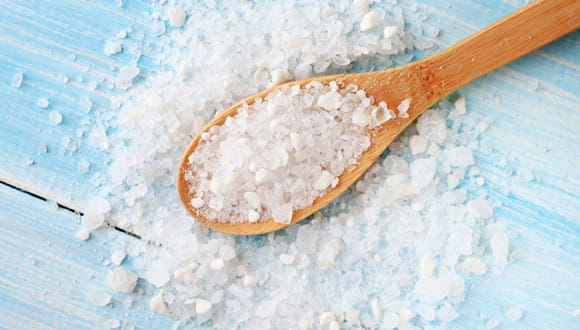Here's Why the FDA Announced Salt Guidance for the Food Industry (& What It Means for You)
Oct. 28, 2021 - Katie McCallumYou've likely heard about the risks of eating too much salt.
"When consumed in excess, salt can damage your blood vessels over time, leading to high blood pressure, heart disease, heart attack and stroke," says Dr. Zuleikha Tyebjee, primary care physician at Houston Methodist. "And not only do most Americans consume salt in excess, most don't even realize they're doing it."
It's why, for decades, doctors have advised people to monitor their salt intake and, if it's high, take steps toward reducing it.
And now, through their new voluntary sodium-reduction goals, the FDA is asking the food industry to reduce the amount of salt found in food in order to help us solve our consumption dilemma, too.
What does the FDA's salt guidance for the food industry mean for me?
Studies show that reducing the average American's salt intake may help prevent tens of thousands of cases of heart disease and stroke every year.
But when more than 70% of our salt intake comes from the sodium that's added during the food manufacturing or preparation process, getting Americans to consume less salt isn't as straightforward as it sounds.
The food supply itself has become an obstacle.
"We lead busy, fast-paced lives and it's not feasible for every meal to be one that's cooked at home and completely from scratch just so you can control exactly how much salt you're getting," says Dr. Tyebjee. "Even if you're not dining out or going to a drive thru, most of the pantry staples that help us put a meal together in a reasonable amount of time contain salt, too."
From bread, cheese, deli meat and condiments to instant mashed potatoes, taco shells and tortillas to canned sauces, beans and vegetables, breadcrumbs and frozen dinners — the salt found in the foods we eat throughout the day adds up.
They add so much that the average American consumes at least 1,000 milligrams more salt than recommended per day.
In addition to asking us — the food consumers — to limit our salt intake, the FDA is now asking food manufacturers to make some changes, too.
"The new guidelines essentially provide a short-term target — 2.5 years — for the recommended average sodium content of a variety of food categories, as well as the recommended maximum sodium content for specific food items within the particular categories," explains Dr. Tyebjee.
By asking food manufacturers and restaurants to make these changes, the FDA hopes to reduce the amount of salt the average American consumes by 400 milligrams — from 3,400 down to 3,000.
Keep in mind, however, that these recommendations are just that — recommendations. The new guidelines are voluntary, so you'll still need to check nutrition facts labels and ask about salt content before ordering food from a restaurant.
Plus, the guidelines are just a first step. Getting 3,000 milligrams of sodium is still well above what's recommended per day.
What is the recommended daily salt intake?
The current Dietary Guidelines for Americans from the USDA recommends that people aged 14 and older limit their dietary salt intake to 2,300 milligrams per day.
"Getting more than that is discouraged since regularly consuming beyond 2,300 milligrams of salt per day significantly contributes to developing high blood pressure, which itself is a leading cause of heart disease," says Dr. Tyebjee.
On the flip side, research shows that societies with low-sodium diets see less of the high blood pressure associated with aging that we see here in the U.S. Research also shows us that dietary changes that reduce sodium intake, particularly the DASH diet, can lower blood pressure.
Despite all of this, the average American consumes about 3,400 milligrams of salt per day — well beyond what's recommended.
The FDA's new salt guidance for the food industry aims to get this number down to 3,000 milligrams in the next few years. Which raises the question: Why stop there?
Why not aim to reduce salt intake by more?
The FDA fully acknowledges that their guidelines won't immediately solve the salt intake conundrum. They're not asking us to quit our salt habit cold turkey, in other words.
Officials give several reasons why their initial goal falls short of reducing sodium consumption all the way down to the recommended 2,300 milligrams per day. Two important ones:
- Salt plays an important role in food preservation and flavor, and gradual reductions (both in terms of sodium content and time) are needed to properly account for product reformulation.
- A gradual decrease in salt content will help food consumers adjust their taste buds to lower levels of salt.
Both of these factors are important to account for since they help encourage food manufacturers and food consumers alike to make healthy adjustments to their formulations and dietary habits, respectively.
"What we don't want to see is manufacturers simply replacing salt with another ingredient that adds flavor but is also unhealthy, like added sugar or saturated fat," explains Tyebjee.
Similarly, Dr. Tyebjee says we also don't want people to trade that no-longer-salty snack that just isn't hitting the spot anymore for a snack containing refined sugars or fats since these can lead to a whole other slew of health problems.
"There are some people who need to take immediate steps to lower their salt intake, such as those who already have high blood pressure or heart disease," adds Dr. Tyebjee. "For everyone else, though, the goal should be to slowly change how we approach the saltiness of food until we naturally reach a balance where consuming 2,300 milligrams of salt per day is just as satisfying as the 3,400 milligrams most of us get today."


